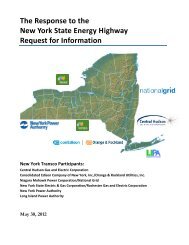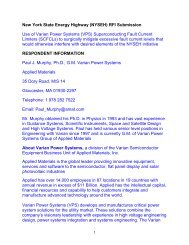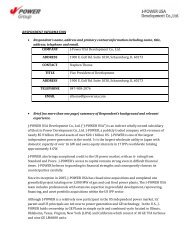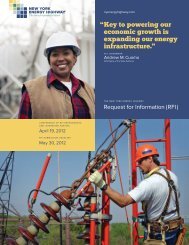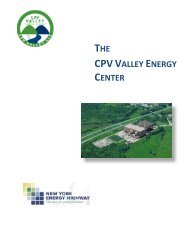Silicon Solution Joint Venture, LLC - Energy Highway
Silicon Solution Joint Venture, LLC - Energy Highway
Silicon Solution Joint Venture, LLC - Energy Highway
You also want an ePaper? Increase the reach of your titles
YUMPU automatically turns print PDFs into web optimized ePapers that Google loves.
US SOLAR – WHITE PAPER 24 May 2012<br />
...with returns of 6.5–9%<br />
on its existing<br />
investments<br />
In 2010, PensionDanmark bought a 50% stake in Dong’s Nysted wind farm for DKK 700m<br />
($130m). In April 2011, PensionDanmark and fellow large Danish pension fund PKA acquired a<br />
50% stake in the Anholt offshore wind park in the north-east coast of Denmark for a total joint<br />
investment of DKK 6bn ($1.1bn). The 400MW project, run by Danish utility Dong <strong>Energy</strong>, will be<br />
the biggest offshore wind farm in Denmark and one of the biggest in the world when completed in<br />
2013. PensionDanmark will own 30% of the asset, and PKA 20%.<br />
PensionDanmark has explained that this direct form of project investment is preferable to<br />
investing in an infrastructure fund because it bypasses high management fees and allows for<br />
greater control. On the other hand, a high level of expertise and a lengthy preparation is required<br />
for such transactions. According to management, the fund has realised returns of 6.5–9% on its<br />
existing investments.<br />
6. POLICY OPTIONS<br />
Under the status quo, US solar will experience significant growth in the coming decade, enabled<br />
by rapidly falling costs and by the drivers identified in this report: new business models for<br />
deployment, new investors, and new vehicles for investment. With adjustments to policy,<br />
however, this growth could potentially be accelerated, and these drivers could be reinforced.<br />
Table 5 in the Appendix sweeps across a range of policies, both existing and proposed, aimed at<br />
promoting US solar. The taxonomy for these is based on Bloomberg New <strong>Energy</strong> Finance's New<br />
<strong>Energy</strong> Policy Library, which tracks implementation of 68 different policy types around the world.<br />
For each that could be relevant to US solar, the table describes the specific application of the<br />
policy that has been enacted or proposed, along with an assessment of its current status or future<br />
viability. 10<br />
Solar investors, developers, and industry advocates have articulated five major themes as high<br />
priority. These cover policies which (a) have either been proposed or are already in place and<br />
could be further strengthened, (b) could be folded relatively easily into existing market structures<br />
or existing policies, and (c) have been cited by investors as examples of policies which could<br />
pave the way for significant increases to investment and solar penetration.<br />
The scarcity of longterm<br />
SREC contracts<br />
makes project<br />
investment a highly<br />
risky merchant bet<br />
• Strengthen existing Solar Renewable <strong>Energy</strong> Credit (SREC) programmes: Solar REC<br />
markets, pervasive in the Northeast US, are often touted by observers with only a superficial<br />
understanding of those markets. Experienced players operating there know the challenges of<br />
those markets: the scarcity of long-term SREC contracts, which makes project investments a<br />
highly risky merchant bet; and the boom-bust cycles, whereby build rates hurry ahead of<br />
regulators' expectations, creating cases of massive SREC oversupply.<br />
Investment in these markets could be supported by strengthening existing standards, which<br />
can be achieved through various means, the most straightforward being lifting or accelerating<br />
the targets for solar carve-outs. New Jersey and Pennsylvania are examples of markets that<br />
are currently flooded with oversupply and whose legislatures are evaluating proposals to<br />
accelerate SREC targets.<br />
A further policy push could focus on mandating availability of long-term contracts. These are<br />
sometimes not easily compatible with load-serving arrangements in deregulated markets but<br />
in some cases have been implemented through creative workarounds; Connecticut, for<br />
example, has recently introduced a carve-out, expected to be filled mostly through solar,<br />
which requires electric distribution companies to allocate funds towards the procurement of<br />
SRECs, which will be procured in standard, 15-year contracts.<br />
10 The list is neither exhaustive nor granular – there may be specific policies being aggressively promoted at<br />
state or even municipal or utility-specific levels, which are not captured here.<br />
© Bloomberg New <strong>Energy</strong> Finance 2012<br />
Strictly no copying, forwarding, shared passwords or redistribution allowed without prior written permission<br />
of Bloomberg New <strong>Energy</strong> Finance. For more information on terms of use, please contact<br />
sales.bnef@bloomberg.net. Copyright and Disclaimer notice on page 28 applies throughout. Page 23 of 28



